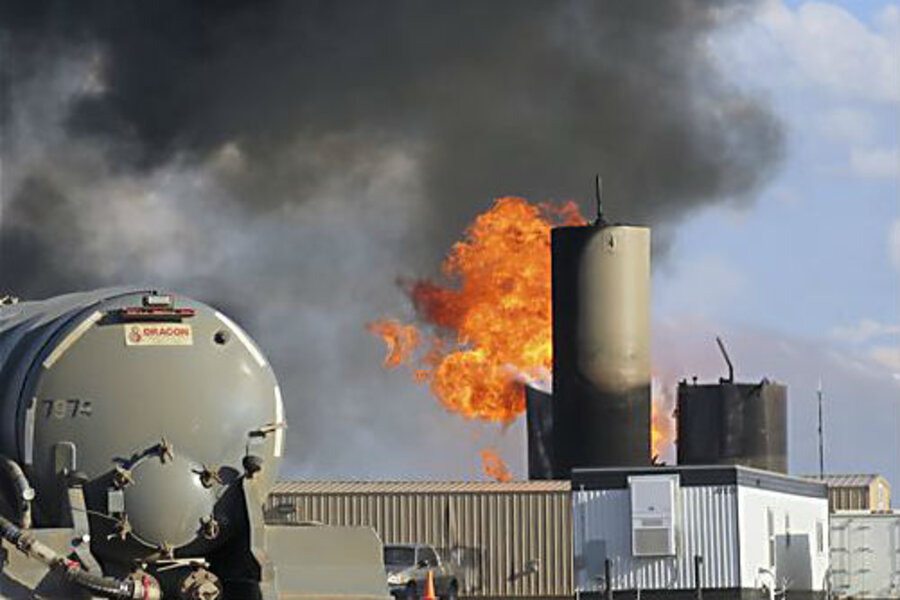Why lightning is a fire risk for fiberglass saltwater tanks
Loading...
| Williston, N.D.
Three massive fires since the beginning of June have highlighted the threat lightning poses in the North Dakota oil patch, and in each case it was tanks that store the toxic saltwater associated with drilling — not the oil wells or drilling rigs — that were to blame.
The lightning-sparked fires destroyed the groups of silo-like storage tanks at the three locations, which are among of more than 440 sites in North Dakota where so-called saltwater is stored before being pumped into permanent disposal sites miles underground. In each case, the fires burned for days, spewing noxious black smoke into the air and literally salting the earth.
Although disposal tanks aren't likely more susceptible to lightning strikes than similar structures that jut out over the prairie, their fiberglass components and combustible contents make it very likely they'll go up in flames when they are hit.
"You're creating the perfect mixture for ignition," said Bruce Kaiser, president of the Clearwater, Florida-based Lightning Master Corporation, which is one of several companies that provide lightning protection systems to oil field facilities. "Counterintuitively, it's the water tanks that blow up, not the oil tanks."
Also called brine, saltwater is a byproduct of oil production that is between 10 and 30 times saltier than seawater and that contains oil residue when it is put in the tanks, where gas vapors also collect. Companies allow the liquid to settle and separate, then skim and sell off the oil to pad their profits injecting what remains into the ground.
Due to brine's corrosiveness, companies would have to replace their disposal tanks every few years if they were just metal, so they commonly use tanks made of or lined with fiberglass, which last longer.
Metal-only tanks would allow the electricity to pass through them and into the ground more easily than those with fiberglass, said John Jensenius, a lightning safety expert at the National Oceanic and Atmospheric Administration.
"Because fiberglass is more resistant to electrical charge movement, it's going to heat up. That's why you're seeing the fires," he said.
Despite the risks posed by lightning, North Dakota doesn't require companies to install any protections. Some do it anyway — the owner of tanks near the town of Ross that were struck June 27 estimates it will cost $2 million to replace them and clean up the site. But others apparently are unaware of the threat or are willing to take their chances to save money.
Kaiser, who said lightning can affect disposal tanks a quarter-mile away, said the protection systems his company installs can run $1,500 per tank, or less.
Protecting all of the tanks at a single site can run in the tens of thousands of dollars, but the cost of not doing so can be much greater, said Peter Carpenter, an executive vice president at another such company, Lightning Eliminators.
"When one tank goes, to be honest with you, it's like a domino effect," said Carpenter. "When one tank goes, you lose the majority of tanks in that battery."
The fires destroyed nearly all of the storage tanks at the three North Dakota sites that have been struck since the start of June.
Only three of the 14 tanks were left standing after the fire at the site near Ross, where the roughly 24,360 gallons of oil was spilled or burned off and about 75,600 gallons of brine was spilled, according to the state. Alan Krenek, the chief financial officer for the site's owner, Basic Energy Services, said it is standard procedure for the Fort Worth, Texas-based company to install lightning protection systems at its sites, but that it hadn't been installed yet at that one.
But "just because you have lightning protection equipment on board doesn't necessarily mean that it won't happen," said Krenek.
Indeed, the owners of the other two sites that burned say they had taken precautions, but to no avail.
The most recent, a July 7 strike at a facility next to a popular highway truck stop near the town of Alexander that burned for days, spilled about 118,146 gallons of brine and spilled or burned off roughly 27,258 gallons of oil. Fred Kershisnik, the president of the site's owner, 1804 Operating, told The Associated Press that the site was grounded and the company thought it had taken all the steps to minimize the risks lightning posed, but will be reviewing how it protects sites.
A June 1 lightning strike on an Oasis Petroleum saltwater disposal facility in Williams County sparked a fire that completely destroyed the facility, spilling or burning off about 630 gallons of oil and about 50,400 gallons of brine. Oasis' vice president of finance, Richard Robuck, told the AP that the company had implemented lightning prevention measures at the site before it was struck.
___
Contact Josh Wood at https://twitter.com/JWoodAP
Copyright 2014 The Associated Press. All rights reserved. This material may not be published, broadcast, rewritten or redistributed.







